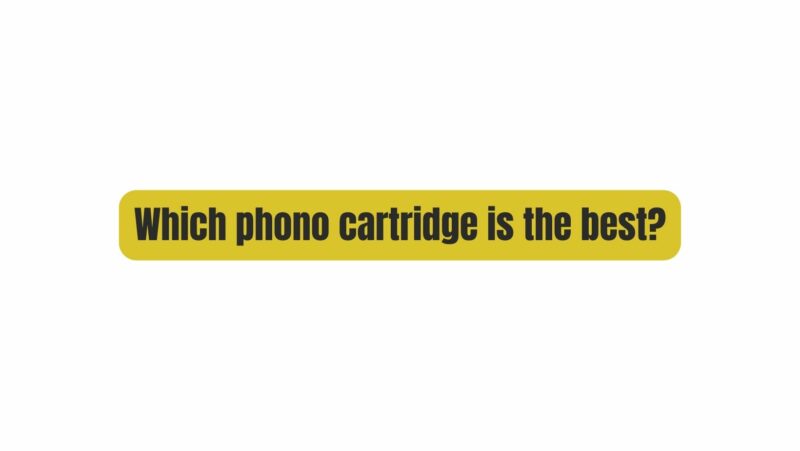In the ever-evolving world of audio, the vinyl resurgence has captured the hearts of music enthusiasts and audiophiles alike. As vinyl records continue to spin on turntables around the world, the quest for the best phono cartridge remains an ongoing pursuit. But what makes a phono cartridge the best? This article embarks on a sonic journey to explore the intricacies of phono cartridges and the factors that determine their quality.
The Essence of the Phono Cartridge
A phono cartridge, often referred to simply as a “cartridge,” is a small but crucial component in the vinyl playback chain. It serves as the interface between the grooves of a vinyl record and the rest of the audio system. The cartridge’s primary function is to transform the mechanical vibrations etched in the grooves of the record into an electrical signal that can be amplified and reproduced as sound.
The Nuances of Cartridge Design
Before diving into the pursuit of the best phono cartridge, it’s essential to understand the key components and design elements that differentiate various cartridges:
- Stylus: The stylus, often referred to as the needle, is the part of the cartridge that physically makes contact with the record’s grooves. It is responsible for tracking the grooves accurately and translating the mechanical vibrations into electrical signals. Styluses come in various shapes, including elliptical, spherical, and line contact, each affecting tracking ability and sound quality differently.
- Cantilever: The cantilever is a tiny rod that holds the stylus. It transfers the stylus’s movement to the cartridge’s core components. The material and design of the cantilever can impact the cartridge’s ability to track grooves accurately and transmit vibrations effectively.
- Cartridge Body: The cartridge body houses the internal components and plays a role in the overall resonance and vibration control. Cartridge bodies are typically made of materials like aluminum, plastic, or wood.
- Coil and Magnet Assembly: The core of a phono cartridge is the coil and magnet assembly. When the stylus moves in response to the grooves, it induces electrical currents in the coils. These currents are then sent to the phono preamp for amplification.
- Moving Magnet (MM) vs. Moving Coil (MC): Cartridges are broadly categorized into MM and MC types based on the type of coil used. MM cartridges are known for their affordability and ease of use, while MC cartridges often offer higher fidelity but can be more expensive and demanding of the rest of the system.
The Quest for the Best: Factors to Consider
Now, let’s delve into the factors that audiophiles consider when searching for the best phono cartridge:
- Sound Quality:
- Tonal Balance: A great cartridge should offer a balanced and natural tonal response, faithfully reproducing the frequencies present in the original recording.
- Detail and Resolution: A top-tier cartridge will capture the subtle nuances, textures, and details in the music, enhancing the listening experience.
- Tracking Ability: The cartridge should track the grooves accurately, even in demanding passages, without distortion or skipping.
- Compatibility with Turntable and Tonearm:
- Turntable Matching: The best cartridge for you depends on your turntable’s specifications and compatibility. Consider the turntable’s tonearm mass, compliance, and wiring.
- Tonearm Matching: The cartridge’s compliance (ability to absorb vibrations) should be matched to the tonearm’s effective mass to ensure proper tracking.
- Budget and Value:
- Value Proposition: While some high-end cartridges deliver exceptional performance, it’s crucial to assess whether the improvements in sound quality justify the cost.
- Budget Constraints: Consider your budget and explore cartridges within that range, as there are excellent options available at various price points.
- Musical Genre and Preferences:
- Musical Genre: Different cartridges may excel in reproducing specific music genres. Consider your musical preferences when selecting a cartridge, as some may emphasize bass, midrange, or treble.
- Listening Preferences: Your personal listening preferences, such as a preference for warm or analytical sound signatures, should guide your choice.
- Upgradability and Maintenance:
- Upgradability: Some cartridges allow for stylus upgrades or even complete cartridge replacements while retaining the same body. Consider whether the cartridge offers room for future upgrades.
- Maintenance: Regular stylus cleaning and cartridge alignment are essential for maintaining sound quality and prolonging the cartridge’s lifespan.
The Subjectivity of Sound
It’s essential to recognize that the quest for the best phono cartridge is subjective. What sounds best to one person may not be the same for another. Listener preferences, the rest of the audio system, and the acoustics of the listening room all contribute to the perception of sound quality.
Moreover, the “best” cartridge may vary depending on the specific vinyl records in your collection. Some cartridges may excel in reproducing classical music, while others may shine with rock or jazz.
Conclusion: A Harmonious Journey
The pursuit of the best phono cartridge is a harmonious journey where subjective preferences meet technical specifications. It’s a quest that invites exploration, experimentation, and a deep connection with music. While the audiophile world may be filled with choices and debates, the ultimate goal remains the same: to rediscover the beauty of analog sound and relish the intimate connection that vinyl records offer.
In the end, the best phono cartridge is the one that resonates with your ears, complements your musical taste, and enhances the magic of vinyl playback. Whether you seek the warmth of a moving magnet or the precision of a moving coil, the world of phono cartridges invites you to savor the diverse and timeless pleasures of analog audio.

